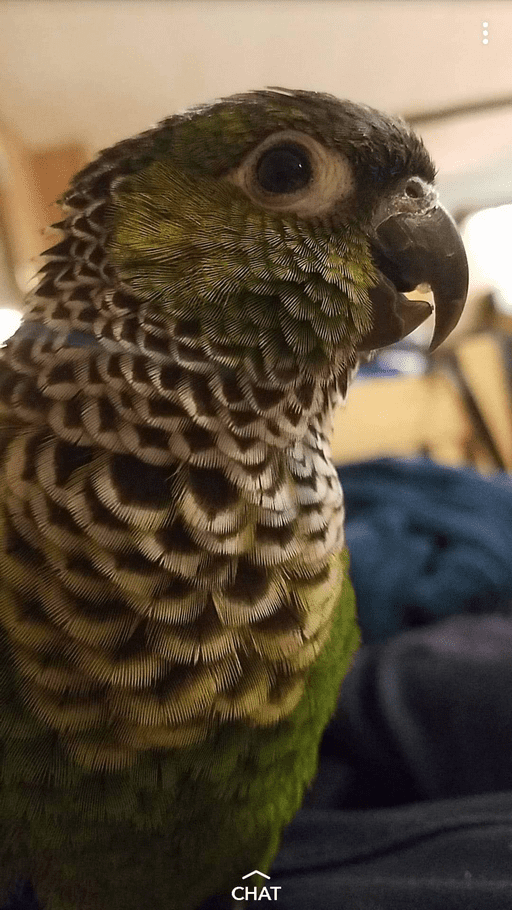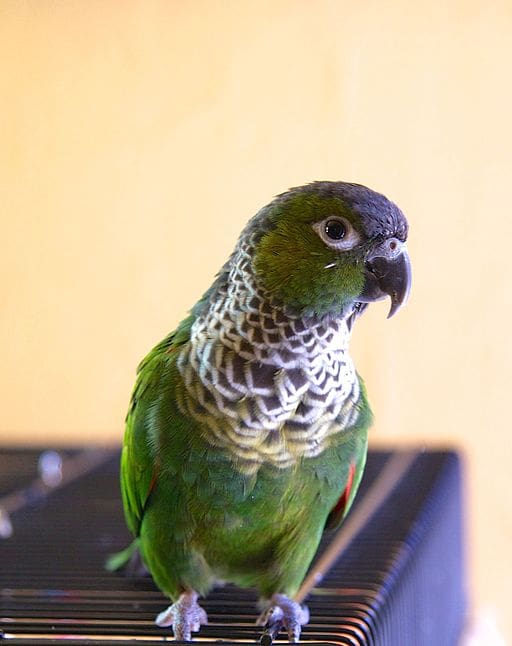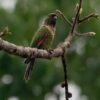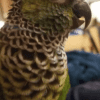Black-capped Conure
Also known as:
Black-capped Parakeet, Rock Conure
Also known as:
Black-capped Parakeet, Rock Conure

Pyrrhura

rupicola
Size:
25 cm (9.75 in)
Weight:
70 g (2.45 oz)
Subspecies including nominate:
two: P.r. rupicola, P.r. sandiae
Colour Adult:
P.r. rupicola: Both adults black forehead to occiput; green cheeks, ear coverts and line above eye; black hindneck with off-white scalloping to feathers; dark brown breast scalloped with off white; lower breast washed with dull yellow; red primary coverts and carpal edge; green tail. Beak black. Bare eye ring grey, eye brown.
P.r. sandiae: Both adults narrower off-white scalloping to neck and breast; on hindneck almost none.
Colour Juvenile:
As in adults but duller; green primary coverts and carpal edge. Cere and bare eye ring white.
Call:
Calls made in flight high-pitched yapping sounds.
More Information:
Content Sources:
CITES
BirdLife International
Cornell Lab of Ornithology/Birds of the World
Parrots: A Guide to Parrots of the World, Juniper and Parr, 1998
Parrots of the World, Forshaw, 2006. 2010 edition
Parrots in Aviculture, Low, 1992.
Lexicon of Parrots, Thomas Arndt.
Captive Status:
Uncommon
Longevity:
—
Housing:
Aviary or suspended enclosure, minimum length 2 m (6.5 ft).
Diet:
Fruit such as: apples, pears, bananas, oranges, cactus fruits, forming about 30 percent of diet; vegetables such as: carrot, celery, green peas in the pod and beans; fresh corn; green leaves such as: Swiss chard, lettuce, kale, dandelion, chickweed; small seed mix such as: canary, millet, safflower, millet; limited soaked and sprouted sunflower; cooked beans and pulses, boiled maize and complete kibble.
Enrichment:
Vigorous chewer; provide lots of bird-safe branches (unsprayed) such as fir, willow, elder and pine; vegetable tanned leather toys. Shallow water bowls for bathing.
Nest Box Size:
8″ x 8″ x 30″ (20.3 cm x 20.3 cm x 76 cm) vertical box.
Clutch Size:
5-7
Fledging Age:
7-8 weeks
Hatch Weight:
—
Peak Weight:
—
Weaning Weight:
—
World Population:
100,000-500,000 mature individuals, stable.
IUCN Red List Status:
Least Concern
CITES Listing:
Appendix II
Threat Summary:
Not globally threatened. A BirdLife “restricted-range” species. Fairly common. Forest loss within the range has been small over the last ten years.
Range:
P.r. rupicola: CE Peru.
P.r. sandiae: SE Peru to W Brazil and N Bolivia.
Habitat:
Found up to 300 m (984 ft), in humid lowland tropical forest, including varzea and terra firme. Sometimes found in E Andean foothills.
Wild Diet:
Recorded feeding on Cecropia fruits.
Ecology and Behaviour:
Feeds in canopy. Resident. Found in pairs or small family groups during breeding season; at other times in flocks of up to 30 individuals. Roosts communally.
Clutch and Egg Size:
Up to 7 in captivity.
Breeding Season:
September.
Related Links:
—





![© David Brossard [CC BY-SA 2.0] via Wikimedia Commons A companion Black-capped Conure perches atop a cage](https://parrots.org/wp-content/uploads/2023/01/wpt_Black-capped-Conure_1353-1-100x100.jpg)